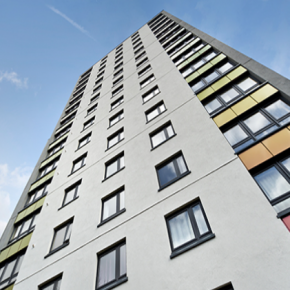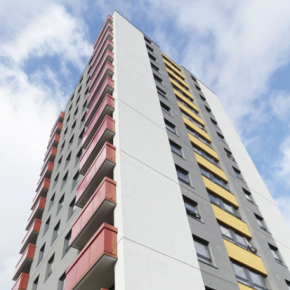
What specifiers should look for in their EWI system
Alumasc’s Technical Director Mark Gibbs discusses what specifiers should look for in their EWI system for high-rise and the importance of safe installation.
Specification for the multi-storey application of External Wall Insulation is very different to that of low-rise projects, with health and safety procedures being a key consideration in the thermal upgrade of high-rise buildings.
High rise projects for the last 25 years have been refurbished using EWI, as a cost effective method of achieving thermal and aesthetic upgrade of buildings.
EWI solves the issue of condensation, water ingress and poor thermal performance of many of the blocks and provides a U-value to comply with current Building Regulations.
The appropriate type of EWI insulation board is mechanically and adhesively fixed to the substrate to achieve the thermal requirements of the project. A polymer modified reinforcing base coat, incorporating a fibreglass reinforcement mesh, is then applied.
Various finishes are available, ranging from traditional dash or painted renders to more modern through-coloured silicone renders, once it has fully cured.
The insulation boards of high-rise EWI specification must be adhesively and mechanically fixed. To accommodate higher wind loads, calculations must be made and the edge zones, and increased mechanical fixings are required for external corners and openings.
The calculations must always be conducted by Structural Engineering Consultants to ensure structural stability, required performance and system longevity.
For use in high-rise application, specified EWI systems must be officially accredited and approved. The system requires a large scale fire test or reaction to fire test when used above 18m in height.
There are additional detailing considerations compared to low-rise, as well as through-the-wall square metre rates. Including parapet, lightening conductor, CCTV, external lights, robust window cill details, ground floor entrance areas etc.
It is critical that all detailing is robust and installed as per specification .Any repairs are more difficult and costly to address than for low-rise projects once the wall access is removed. Scaffold ties should be fixed in the most practical locations and protected scaffolding is recommended.
Mast climbers are an economical and faster track option for EWI install, however they offer less protection to newly installed work. Programming considerations should always allow for weather conditions.
Alumasc Facades,
White House Works,
Bold Road,
Sutton,
St Helen's,
Merseyside,
United Kingdom
WA9 4JG
Phone: 01744 648400
Visit Supplier's page
Latest news

31st March 2025
HMG Paints renew partnership with Belle Vue Aces Speedway
HMG Paints has renewed its partnership with Belle Vue Aces for the 2025 season. This year marks a particularly exciting chapter for Belle Vue Speedway, as the club and National Speedway Stadium will host an electrifying double-header of the FIM Speedway Grand Prix in 2025.
Posted in Articles, Building Industry News, Building Products & Structures, Case Studies, Interiors, Paints, Paints, Coatings & Finishes, Posts, Restoration & Refurbishment, Retrofit & Renovation
31st March 2025
Ideal Heating sponsored CIBSE BPA Engineer of the Year announced
As the sponsor of the Engineer of the Year award at the Chartered Institution of Building Services Engineers (CIBSE) Building Performance Awards, Ideal Heating Commercial was delighted to present the award to Volkan Doda, Head of Design Technologies at Atelier Ten.
Posted in Articles, Awards, Building Associations & Institutes, Building Industry Events, Building Industry News, Building Products & Structures, Building Services, Facility Management & Building Services, Heating Systems, Controls and Management, Heating, Ventilation and Air Conditioning - HVAC, Pipes, Pipes & Fittings, Plumbing, Retrofit & Renovation
28th March 2025
Ideal Heating Commercial announces 10-year warranty on Evomax 2 boiler
Evomax 2, the UK’s number one selling commercial wall-mounted boiler from Ideal Heating Commercial, is now available with a 10-year warranty.
Posted in Articles, Building Industry News, Building Products & Structures, Building Regulations & Accreditations, Building Services, Facility Management & Building Services, Heating Systems, Controls and Management, Heating, Ventilation and Air Conditioning - HVAC, Innovations & New Products, Pipes, Pipes & Fittings, Plumbing, Retrofit & Renovation, Sustainability & Energy Efficiency, Videos
28th March 2025
FLIR Si1-LD Acoustic Imaging Camera for Compressed Air Leak Detection
FLIR, a Teledyne Technologies company, introduces the Si1-LD, an industrial acoustic imaging camera that brings faster and more accurate compressed air leak detection to those operating on a modest condition monitoring budget.
Posted in Acoustics, Noise & Vibration Control, Articles, Building Industry News, Building Products & Structures, Building Services, Facility Management & Building Services, Information Technology, Innovations & New Products, Retrofit & Renovation, Sustainability & Energy Efficiency, Thermal Imaging and Monitors
 Sign up:
Sign up: 